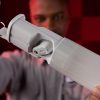I’ve been reviewing several inexpensive wireless ANC headphones lately, most recently the EarFun Wave Pro, and this review of the JLab JBuds Lux ANC headphones ($79.99 MSRP, but usually available for less) fits right into that initiative. JLab’s mission statement states that they pack in the most functionality and fun into every product at a truly accessible price, so if the functionality is there, they may indeed represent what JLab calls “Surprisingly Awesome Value.”

Fit ‘n Finish
The unboxing experience is typical of budget offerings with the headphones and a charging cable the only two items included in the package. The headphones themselves are offered in four colors: sage green, graphite black, cloud off-white and mauve. For Transformers fans, the Lux is also available in Limited Edition Autobot Red and Decepticon Purple versions at a $10 price premium. I opted for the graphite black version for review.
I should mention that pricing seems to vary considerably on the JBuds Lux. Amazon is currently offering a $16 coupon on the Sage Green, Autobot and Decepticon versions. And Best Buy currently has the Graphite Black and Off-White versions available for as low as $49.99. Your mileage may vary as far as pricing is concerned.

The headband is steel and is visible when not adjusted to the smallest setting. The top is wrapped in protein leather with the JLab name in relief while the underside of the band is cloth-wrapped memory foam for added comfort.

The headband terminates with hinges that allow the cups to fold for storage. The gimbals allow for 90° rotation to the front and roughly 20° rotation to the rear on the vertical axis and roughly 30° on the horizontal axis. With the cups tilted on the horizontal axis, a hidden port on the top face of the cups is visible as a series of slits.

The earcups themselves are egg-shaped with the wider end toward the top and a large raised JLab logo on the lower end. The left cup is smooth while the right cup has the USB type-C charging port at bottom, followed by a power button, volume rocker, and noise cancelling selection button. Pads are memory foam wrapped in protein leather and are non-removable as is often the case in the budget segment. Most of JLab’s products are rated for outdoor and gym use but I could find no information on IPX rating so would advise the JBuds Lux be treated as not water tolerant.
It’s What’s Inside That Counts
Internally, the JBuds Lux sport 40mm dynamic drivers with a nominal impedance of 16Ω and a sensitivity of 98 dB/mW. Bluetooth is version 5.3 but the only codec supported is SBC which is somewhat disappointing as I had hoped for AAC as well. Still, quick pairing is supported on Android devices and, within reasonable distances, connectivity was solid. The provided USB cable can also be used to connect the headphones for hard-wired listening but be aware that no 3.5mm option exists and the headphones cannot be used un-powered. So they aren’t the best choice for tapping into that in-flight entertainment system. The headphones will charge while listening via the USB cable, but will do so more slowly than charging while powered off.

Ergonomically Speaking
There are auditory prompts for power on, ready to pair, connected and battery capacity that allow for use of the headphones without the JLabapp when pairing to a laptop, etc. But the JLab app does unlock additional features like firmware updates, equalizer, safe hearing, music and movie mode, and the ability to adjust the functions of the buttons. There are auditory prompts for most functions in the app so feedback is very positive which is nice.
One thing I found interesting in the audible prompts is that the default EQ setting is labeled EQ1 in the JLab app but the spoken description is “Signature.” EQ2 gives a “Balanced” prompt and EQ3 results in a “Bass Boost” prompt. None of these settings are neutral as even “Balanced” has a mild V-shaped EQ curve. The only way to set the JBuds Lux to neutral is to choose custom EQ and set the sliders to their neutral position. There is no “off” button for EQ, so be aware that some profile is in use at all times.

ANC and awareness mode can be turned on and off via the button on the headphone or via the app, but the app provides an additional slider that allows the user to dictate how much noise is cut or let in depending on the ANC setting in use.
Battery life is listed as 40 hours with ANC enabled or 70 hours without. In my tests I was able to consistently get that or a bit over it which puts the JBuds Lux in the middle ground of all tested over-ear wireless headphones. Still, with the ability to listen for an entire work week without need of a recharge, there is little to complain about here. And with a quick 10-minute charge netting 4 hours of listening time, even if you should find the battery running low, it’s an easily remedied issue.
I used a number of different sources and the Jbuds Lux did well with most of them as far as the reliability of the connection went. But when using SBC, it is easy to see that not all sources are created equal. The distance from source device before drop-out varied and barriers defeated the connection more readily with some sources than others.
Listening Notes
I did my listening using the JLab Signature sound setting (EQ1), unless otherwise noted, as this is the default sound and, without using the app, the only sound profile available. This setting accentuates the mid-bass and lower-treble regions to produce a typical V tuning.
Bass is clearly the focus of these ‘phones with some sub-bass rumble combined with a lot of mid-bass. There is notable roll-off from the mid 30Hz range down. Interestingly, I found that even using the custom EQ and adjusting the 31Hz band that I could not add or cut the levels of sub-bass substantially so it seems to be a limit of either the driver or the electronics. Mid- bass on the other hand has big punch with an emphasis centered around 150Hz. Those looking for big bass will appreciate the tuning while those of us wanting a bit more balance will likely choose either the balanced or custom EQ profile that allows a bit more detail at the expense of a bit of that bass lift.
Mids are scooped when using EQ1 and take a clear backseat to both the higher and lower frequencies. As a lover of mids, I found myself immediately going to the custom EQ setting and pushing both the 500Hz and 1kHz sliders up slightly. This allowed mids to compete with the ranges above and below and vocals to cut through the instrumentation more. Even with that, mids are not the star of the show as the driver retains some of the V shape independent of the EQ settings.
The same can be said for some of the treble range as there is a lift in the lower treble followed by a larger rise in the 5kHz range and a rapid decline above about 9kHz that keeps percussion snap from being fully realized and limits the amount of detail presented in the treble. Cymbals are a bit clicky and hot. This lift above the 4kHz range adds some sparkle which can easily become overwhelming if the track leans that way already.

The lack of openness also keeps the soundstage from realizing any depth with the result being a stage that is disproportionately wide and shallow. Seating the orchestra results in a chart that has instruments out wider than natural and only about 3 rows deep. Instrument separation is limited with some distortion and compression creeping in at higher volumes especially in the lower ranges.
Like most ANC headphones, the degree of ANC or “aware” mode used impacts the clarity of the sound. In the case of the JBuds Lux, the best sound is found with minimal ANC applied and the worst by far is with aware set to maximum. Aware lets way too much outside noise in and amplifies every shuffling of paper and even distant noises. It’s a case of too much of a good thing. Moderate ANC did have some impact on the sound with a bit of clarity lost to noise control but it was still quite tolerable and I came away thinking the JBuds Lux will be better suited to the bus or plane ride than in an office or outdoor setting where awareness mode is needed. Likewise, both ANC in the ear and noise reduction on the microphone suffered from an inability to filter out wind noise reinforcing the idea that these may be better suited for indoor situations.

The Bottom Line
It would be easy to say that the JLab JBuds Lux aren’t as good as something like the Sony WH-1000XM5, but the fact that you can buy 4 or 5 pairs of the JBuds Lux for roughly the price of one pair of the Sonys can’t be overlooked here. At roughly $80 USD, but sometimes available as low as $50, we are likely to have to sacrifice something to keep price down, so the question becomes, “are the things sacrificed here things that were important to you?” For those looking for an inexpensive headphone with decent sound, big bass, and a week’s worth of battery life, the JLab Jbuds Lux ANC will hold appeal. Be aware though that these are not IPX-rated and somewhat susceptible to wind noise so outdoor use isn’t in their wheelhouse.
Pros:
- Great price for solid performance
- 40+ hour battery life with ANC engaged
- Easily folded for storage
- Good audio prompts allow app-free operation
- V-tuning is effective at creating a punchy sound
Cons:
- No case included
- Not water tolerant (no IPX rating)
- Wind causes problems for ANC and on calls
- SBC wireless or USB connectivity only
- Awareness mode hurts sound quality
Where to Buy:
Related Reading:





































Chris Boylan
October 30, 2024 at 4:11 pm
Do the Autobot and Decepticon versions transform into Robots? If so, sold!